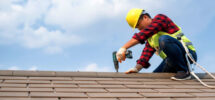Since the 1920’s, flat top residential roofing systems were a mark of commercial and industrial trade, and even an up-to-date version of America itself. However, prior to that, pitched roofs were actually the most popular form of architecture for even larger commercial buildings. However, for roofing contractors and building owners across the globe, the change to flat top residential roofing types provides many advantages. These include the elimination of metal flash-inserts and the decrease in the size of roofs. Ultimately, flat roofs also are more environmentally friendly, as well as more durable and stable.
Although flat roofs are becoming increasingly common across many parts of America, one of the best-known forms is the membrane roof. The membranes used with flat roofs can either be fabricated using polyethylene, or “adhesive” membranes, which are created by applying the adhesive directly to the roofing system and then allowing it to dry. The membrane is then smoothed out using rolling equipment to create a smooth seam. Unlike polyethylene, which must be specially manufactured, the membrane type can be built at a local home improvement store and is easy to install. If the seams are not properly sewn, it can cause the roof to leak.
In addition to the ease of installation, many also find the seams created by roofing membranes as one of the major advantages to these types of roofs. This is because they can provide superior sound insulation, which allows for less noise inside of a building, and for less wasted energy. Additionally, it is no secret that in hot humid climates, the reduction in airflow creates more heat inside of the structure, which can increase the electricity bills as well.
Flat roofs are another type of roof that have found an increasing amount of popularity among residential building owners as well as commercial building owners. These roofs are generally available in two different varieties – pitched and low-sloped. As the name suggests, pitched roofs are sloped to an angle, while low-sloped roofs are not. Many building owners prefer the latter because they are less expensive, but they also do not have to deal with the issues associated with pitched and sloped roofs.
In addition to being easy on the wallet, many find low-sloped roofs to be easier to maintain as well. Because they are not pitched or sloped, they tend to stay cleaner and less messy than other types of roofs. This means that building owners who are willing to invest the time necessary to properly care for their standing water can reduce their maintenance costs. This is something that any commercial roofing company worth their salt will tell a potential client.
Whether a building owner chooses a metal roof or one of the other types discussed above, there are some key benefits to choosing either one of the two. In particular, those who are considering retrofitting their existing metal roof with a newer version should take a look at the benefits above. Those who are considering this roof should also pay close attention to the disadvantages listed above in order to avoid making an expensive mistake. No matter what type of roof a building owner decides to put on their roof, however, they need to make sure that they are fully aware of all of the pros and cons before they commit themselves to pay for it.
This post was written by tough guy Williams! tough guy is that the owner of A previous Time Roofing that is that the premier Largo Roofing Contractor! tough guy could be a Master Elite Weather Stopper GAF Roofing Contractor, a double award winner of Best Steep-Slope Contractor from GAF, and mortal of Master Elite client Protection Excellence from GAF. He has been serving the Pinellas County space since 1978. previous Time Roofing has been a practice in quality craft, service residential and business properties.


